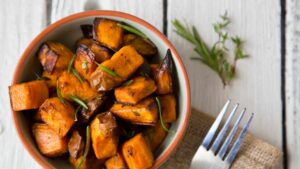Shopping for Healthier Food Options
go.ncsu.edu/readext?1031090
en Español / em Português
El inglés es el idioma de control de esta página. En la medida en que haya algún conflicto entre la traducción al inglés y la traducción, el inglés prevalece.
Al hacer clic en el enlace de traducción se activa un servicio de traducción gratuito para convertir la página al español. Al igual que con cualquier traducción por Internet, la conversión no es sensible al contexto y puede que no traduzca el texto en su significado original. NC State Extension no garantiza la exactitud del texto traducido. Por favor, tenga en cuenta que algunas aplicaciones y/o servicios pueden no funcionar como se espera cuando se traducen.
Português
Inglês é o idioma de controle desta página. Na medida que haja algum conflito entre o texto original em Inglês e a tradução, o Inglês prevalece.
Ao clicar no link de tradução, um serviço gratuito de tradução será ativado para converter a página para o Português. Como em qualquer tradução pela internet, a conversão não é sensivel ao contexto e pode não ocorrer a tradução para o significado orginal. O serviço de Extensão da Carolina do Norte (NC State Extension) não garante a exatidão do texto traduzido. Por favor, observe que algumas funções ou serviços podem não funcionar como esperado após a tradução.
English
English is the controlling language of this page. To the extent there is any conflict between the English text and the translation, English controls.
Clicking on the translation link activates a free translation service to convert the page to Spanish. As with any Internet translation, the conversion is not context-sensitive and may not translate the text to its original meaning. NC State Extension does not guarantee the accuracy of the translated text. Please note that some applications and/or services may not function as expected when translated.
Collapse ▲
Shopping for healthier food options can be a challenge these days, with the abundance of choices available at the grocery store. To maintain a healthy diet and save money, it’s important to plan ahead and have knowledge of the best foods and sales. Here are some tips from the United States Department of Agriculture (USDA) for your next grocery shopping trip, to help you make the most out of your time and money.
Before you go shopping, make sure you know how much money you have to spend on food, including the amount on your EBT card. Also, take inventory of the food you already have at home and plan to use it first. Create a shopping list based on your budget, and check prices on the website of your local grocery store. Only buy foods that you can eat before they spoil, and consider purchasing frozen, canned, or shelf-stable foods that will last longer than perishable items. If you decide to buy bulk or large packages of food, make sure you have the time to divide, package, and freeze them.
Before you start shopping, plan your meals and snacks for the week. This will help you choose items more carefully and keep track of leftovers. Look online for coupons, sales, and store specials to get the best value for your money. Sign up for store discount cards or bonus cards, if available, and if you are comfortable providing any information that might be requested.
When you are at the store, try not to shop while you’re hungry. Make sure you eat before heading out so that you can more easily stick to your shopping list. Try store brands as they are usually the same quality but cost less. Compare products to find the best deal, and always check the “use by” and “sell by” dates to buy the freshest item possible.
When you get home, store your fresh food in the freezer or refrigerator right away. If you buy a large amount of fresh food, such as meat, poultry, or fish, divide it into smaller portions and freeze them. Remember to label the foods with the purchase date, and always use food with the earliest expiration date first.
Apple Glazed Sweet Potatoes

Ingredients:
So easy, just simmer sweet potato slices in juice and serve.
- 2½ cups unsweetened 100% apple juice
- ½ teaspoon ground cinnamon
- ¼ teaspoon salt
- 2 pounds sweet potatoes (about 4 small potatoes), peeled and thinly sliced
Preparation
- Combine apple juice, cinnamon, and salt in a large skillet. Add sliced sweet potatoes and bring to a boil over high heat.
- Reduce heat slightly and simmer potatoes, stirring occasionally, for 20 to 25 minutes or until potatoes are tender and juice has been reduced to a glaze. Serve while hot.
Makes 4 servings – ½ cup per serving.
Nutrition Information:
- Calories: 208
- Total Fat: 0 g
- Saturated Fat: 0 g
- Trans Fat: 0 g
- Cholesterol: 0 mg
- Sodium: 200 mg
- Total Carbohydrate: 50 g
- Dietary Fiber: 5 g
- Protein: 3 g
If you need further assistance in developing a household food budget, More In My Basket offers a session that focuses on the importance of developing a household budget, including a food budget. You will also learn strategies for tracking expenses and developing a budget. Contact Sheila Gregory via email at sheila_gregory@ncsu.edu or via phone at 252-232-2261 for more information.
For questions about the Supplemental Nutrition Assistance Program or to receive application assistance contact the More In My Basket staff:
Visit: morefood.org
English Toll-Free: 1-855-240-1451




